About Cashew Fruit
Talk about weird fruits! Ripe cashews protrude from swollen red stems like tiny, grayish-green boxing gloves at the ends of Popeye’s gigantic forearms. The decadently buttery cashew taste we love comes only after they’ve been properly harvested and processed. Until then, exposure to their toxic oils invites a rash of itching, oozing blisters.
When to Harvest
In their native tropical range, cashew trees (Anacardia occidentale) flower and fruit at the beginning of winter’s dry season. Where they grow in USDA zones 10b through 12, they flower in spring. After two to three months, they’re ready to harvest if:
- The nuts are about 1 inch long and grayish-green.
- The cashew apples are yellowish-red.
- The apples have begun dropping to the ground.
How to Harvest
To harvest cashews, you need:
- Heavy gloves
- A long-sleeved shirt
- Long pants
- Heavy shoes and socks
- Eye protection
- Collection boxes or baskets
In your protective clothing and gear, gather the fallen fruit in collection containers. Check the trees regularly; the nuts will start sprouting if rain falls.
Twist the nuts free from the collected apples and spread them on a flat surface in the sun for four or five days. After they’re dry, store them in their shells for up to two years in a cool, dry place.
Processing Cashews
Home growers willing to risk exposure to cashews’ nasty oils have two processing options. Both require the same protective clothing as harvesting.
- Freeze the nuts overnight and shell them before they thaw. Then wash them thoroughly to remove any traces of oil.
- Cover your clothes with a full-length apron and replace the safety glasses with a clear mask. Heat a pan of oil to 210°F (98.9°C) and drop in the nuts gently so the oil doesn’t spatter. Leave them for just two minutes, then cool them in a container of water, shell and dry them.
Expert gardener’s tip: Because it accumulates traces of oil, never use your cashew-processing equipment for anything else. That said, if there’s any chance of having your cashews professionally processed, go for it!
